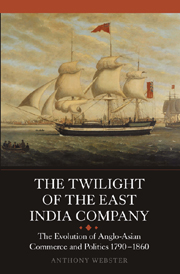 The Twilight of the East India Company
The Twilight of the East India Company Book contents
- Frontmatter
- Contents
- Preface
- 1 Introduction: The end of the East India Company, the historians and the evolution of Anglo-Indian commerce and politics
- 2 The origins of the East India Company and the rise of non-Company commercial interests in Britain, India and Asia, 1600–1793
- 3 War, politics and India: The battle for the East India Company trade monopoly, 1793–1813
- 4 Accommodating free trade: India, the East India Company and the commercial revolution of 1814–1830
- 5 Crisis and trade liberalisation 1830–1834: Financial chaos and the end of the East India Company's commercial role and privileges
- 6 Re-ordering Anglo-Asian commerce and politics: 1833–1847
- 7 Crisis, the resurgence of London and the end of the East India Company: 1847–1860
- 8 Conclusion: The decline of the East India Company and the evolution of British commercial and political interests in Asia, 1793–1860
- Notes
- Bibliography
- Index
6 - Re-ordering Anglo-Asian commerce and politics: 1833–1847
Published online by Cambridge University Press: 12 September 2012
- Frontmatter
- Contents
- Preface
- 1 Introduction: The end of the East India Company, the historians and the evolution of Anglo-Indian commerce and politics
- 2 The origins of the East India Company and the rise of non-Company commercial interests in Britain, India and Asia, 1600–1793
- 3 War, politics and India: The battle for the East India Company trade monopoly, 1793–1813
- 4 Accommodating free trade: India, the East India Company and the commercial revolution of 1814–1830
- 5 Crisis and trade liberalisation 1830–1834: Financial chaos and the end of the East India Company's commercial role and privileges
- 6 Re-ordering Anglo-Asian commerce and politics: 1833–1847
- 7 Crisis, the resurgence of London and the end of the East India Company: 1847–1860
- 8 Conclusion: The decline of the East India Company and the evolution of British commercial and political interests in Asia, 1793–1860
- Notes
- Bibliography
- Index
Summary
THE CHARTER ACT of 1833 certainly ushered in a new era in Anglo-Asian commerce and politics; but there remained much uncertainty about the future. In 1833 a number of issues remained unresolved, in spite of the debates of the previous three years and the hope that a new and more successful order could be established. It is worth outlining the issues which still needed to be resolved before addressing how the various interests connected with India sought to deal with them. First of all, it is important to understand that in 1833, the great financial crisis in Calcutta of the early 1830s had not yet run its course. Although the last of the great agency houses was not to fail until early in 1834, the scale and seriousness of the upheaval was beyond doubt a year earlier. This was clear even in London by then following the failures of several London East India agency firms. Some London East India houses had already begun to adjust to the aftermath of the crisis, by sending representatives to Calcutta either to set up new partner agency houses or to cultivate links with newer merchant firms established since 1813. But in 1833 it remained unclear how these new relationships between London and Calcutta commercial houses would operate. It was plain that the London houses wanted more control over the commercial operations the Calcutta firms would engage in, following the disastrous consequences arising from the combination of banking with speculative enterprise.
- Type
- Chapter
- Information
- The Twilight of the East India CompanyThe Evolution of Anglo-Asian Commerce and Politics, 1790–1860, pp. 104 - 128Publisher: Boydell & BrewerPrint publication year: 2009


